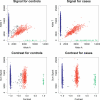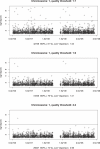A method to address differential bias in genotyping in large-scale association studies
- PMID: 17511519
- PMCID: PMC1868951
- DOI: 10.1371/journal.pgen.0030074
A method to address differential bias in genotyping in large-scale association studies
Abstract
In a previous paper we have shown that, when DNA samples for cases and controls are prepared in different laboratories prior to high-throughput genotyping, scoring inaccuracies can lead to differential misclassification and, consequently, to increased false-positive rates. Different DNA sourcing is often unavoidable in large-scale disease association studies of multiple case and control sets. Here, we describe methodological improvements to minimise such biases. These fall into two categories: improvements to the basic clustering methods for identifying genotypes from fluorescence intensities, and use of "fuzzy" calls in association tests in order to make appropriate allowance for call uncertainty. We find that the main improvement is a modification of the calling algorithm that links the clustering of cases and controls while allowing for different DNA sourcing. We also find that, in the presence of different DNA sourcing, biases associated with missing data can increase the false-positive rate. Therefore, we propose the use of "fuzzy" calls to deal with uncertain genotypes that would otherwise be labeled as missing.
Conflict of interest statement
Competing interests. The authors have declared that no competing interests exist.
Figures



References
-
- Wang WY, Barratt BJ, Clayton DG, Todd JA. Genome-wide association studies: Theoretical and practical concerns. Nat Rev Genet. 2005;6:109–118. - PubMed
-
- Clayton DG, Walker NM, Smyth DJ, Pask R, Cooper JD, et al. Population structure, differential bias and genomic control in a large-scale, case-control association study. Nat Genet. 2005;37:1243–1246. - PubMed
-
- Power C, Elliott J. Cohort profile: 1958 British Birth Cohort (National Child Development Study) Int J Epidemiol. 2006;35:34–41. - PubMed
-
- Moorhead M, Hardenbol P, Siddiqui F, Falkowski M, Bruckner C, et al. Optimal genotype determination in highly multiplexed SNP data. Eur J Hum Genet. 2006;14:207–215. - PubMed
Publication types
MeSH terms
Grants and funding
LinkOut - more resources
Full Text Sources
Miscellaneous

